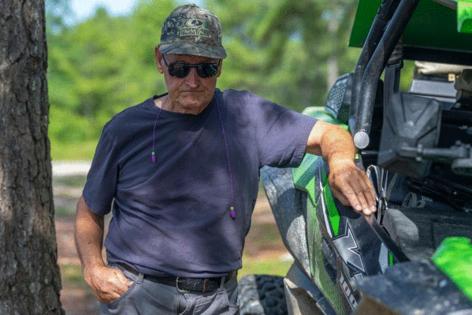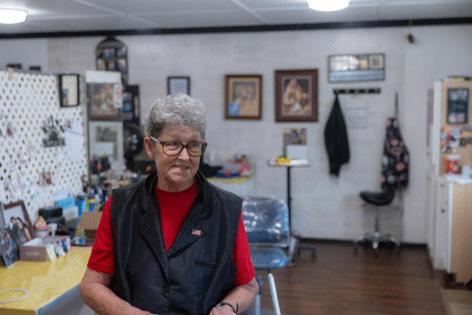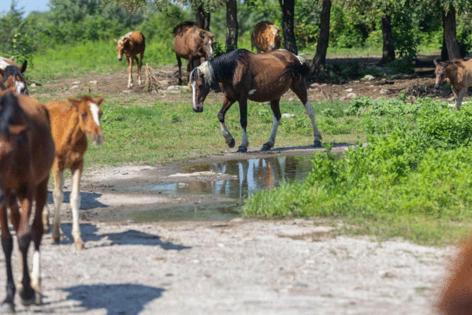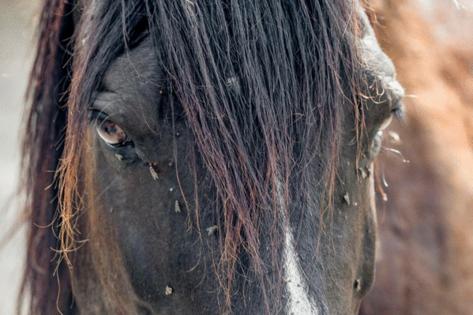Column: Are these wild horses a tourism boon or nuisances that must go?
Published in Lifestyles
ELK VIEW, Ky. -- People drive up to one of the highest points in Breathitt County, Kentucky, to visit the old Clemons-Ritchie Cemetery, which looks out over thousands of wooded acres, or they come to ride all-terrain vehicles around the many trails left by coal companies on defunct strip mines.
Or, they come to see Jasmine, a small bay mare, who, on a recent weekday, wandered in a copse of pine trees with her tiny foal, christened Thor. Jasmine has a good weight on her, even though she’s still nursing Thor and may be pregnant again, but there are tiny seed ticks embedded all over her face in a parasitic braille. More ticks clump together on an open sore.
The horses are approachable, but when Jasmine figures out there’s no food to be had, she walks back to a chestnut stallion further away. The small band consisting of Renegade, Briar and a pinto named Lightning are off in the distance. Jasmine used to run with this band, but seems to have recently decided to hang with the new guy.
“He’s new, I haven’t seen him around much,” explains Marsha Thompson, a guide with the Appalachian Horse Project, a non-profit that advocates for the horses, and takes tours up on the mountaintops as part of an AirBnB experience.
People visiting Red River Gorge or other spots love to see wild horses, more or less, as they wander the high flatlands looking for food. Thompson estimates there might be as many as 500 up here, although they usually travel in much smaller bands.
They’re the descendants of horses that people let free roam in the summer, sometimes picking them up again and sometimes not. The ones left behind kept breeding every year.
The Kentucky Humane Society estimates there could be as many as 1,000 on sites in Floyd, Martin, Knott, Perry, Magoffin, Johnson and Leslie counties. The most famous site is here in Breathitt, where townspeople and tourists can observe Kentucky’s own wild herds, just like in the Outer Banks in North Carolina or out West.
There’s a big difference though. Those herds are managed by state and federal authorities. The Kentucky horses are not. Many of the mares give birth every year so the population swells, leaving fewer resources, and horses plagued by parasites and other diseases.
It’s wintertime when things get complicated. Abandoned mine land vegetation is sparse, so the horses wander down to where people live, where they have lush lawns and gardens to eat. The mineral-depleted forage on the old mines means the horses are desperate for salt, which they sometimes lick off snowy roads, posing a hazard to drivers and themselves.
The long-simmering issue exploded earlier this summer when the fiscal court voted on a resolution to remove the horses. By July 13, all owners were required to remove horses from the site.
Now, they are free for the picking under Kentucky’s stray-hold law, either for someone who wants a pet, or someone who could sell them for a couple hundred dollars to a kill-pen, headed for Mexico or Canada where horse slaughter is still legal.
Of course, it’s one thing to feed an unhandled horse a treat, it’s quite another to try and put on a halter and get it on a horse trailer. For now, the extremely complicated issue is at a standstill: The horses are still there, and it’s not exactly clear how it will be resolved.
“We hope to come up with a compromise,” says Thompson, a native Iowan, who came to Kentucky as a nurse many decades ago. “There are loud voices on both sides. Compromise is not easy, there’s a lot of anger and resentment that has built up. People feel like they’ve been ignored.
“Obviously, something needs to be done.”
Horse herds need management
Exactly what will happen is far from clear. Neither Breathitt County Judge Executive Jeff Noble nor animal control officer Jamie Holbrook returned numerous calls for comment. The fiscal court is to meet July 22 to discuss the matter further.
The Kentucky Humane Society has taken horses from the site before, trained them and gotten them adopted. But it’s hugely expensive, and their equine facilities in Simpsonville are crowded, explained Lori Redmon. They just do not have adequate resources.
The Appalachian Horse Project has gotten grants to hire vets to geld some of the stallions in years past. More recently, employees got a grant for training in using a dart gun to give the mares birth control pellets. But the fiscal court’s resolution put that project on hold.
“If the herd’s population was managed properly, those horses could be a major asset to tourism in Eastern Kentucky,” said Shauneece Wade, executive director of the Appalachian Horse Project. “If you can keep them happy, healthy and safe.”
It’s a big if.
Faith Riley and her family live in a cluster of houses in a picturesque bend in the road, sheltered by lush green grass and a clear-running stream. She, too, likes the horses, but it’s her property that bears the brunt of them in winter, when they wander down off the mountain to find more food. Riley’s grass and garden are a tasty treat for the horses. Sometimes they will chew the paint off cars. Worse, they stand in the road, and Riley can recount at least one car accident caused by swerving to avoid them.
She supports the fiscal court resolution to get them gone.
“The issue is overpopulation,” Riley said. “Even the horse groups will say that, but there’s no way to get them off the hill.”
What she means, of course, is you can pretend they have owners, so they can’t be touched. But they don’t, really, or at least the owners were a few horse generations back.
Riley remembers promises made to have a fenced-in area up the mountain, where they could wander a bit, but not too far, but that plan never materialized.
“That never happened,” she said. “There have been a lot of promises made.”
But with every year, there are more horses, and the problem is getting worse. As Riley notes, the grass on the mountain is sparse and dry. “The grass down here is like a nice juicy steak,” she said.
Her aunt, Phyllis Clemons, lives right down the road, but works at Wayne’s Beauty Shop closer to Jackson.
“I feel so sorry for them,” Clemons said. “Now there’s so many of them, I can’t have a garden.”
The real problem?
“Nobody wants to be responsible for the horses or the damage they cause. I want to be a voice for the horses. I’m tired of seeing them mistreated.”
Horses as ecotourism for Eastern Kentucky
The Appalachian Horse Project costs $50 a person for a three-hour tour. Half the money pays the tour guides and the other half buys salt licks and forage for the horses. If you can’t find the horses, the money is refunded.
Finding them requires a bone-rattling drive over old roads that are more rock and rubble than pavement. But Thompson usually has a good idea where they will be, and we find Hollywood’s band of about 12 gathered under some locust trees. Puddles are full from recent rains, which the horses will drink some, sometimes picking up parasites from them. The Horse Project contracts with scientists from Eastern Kentucky University to see what kinds of parasites the horses are carrying and how to treat them.
Hollywood is a bay stallion, and, as predicted by Thomson, he comes to see the visitors. But as soon as he figures out there are no treats on hand, he gently moves his entire band away from the car and down the road, mares and foals following behind. He’s not interested in socializing, and it’s hard to imagine hustling him onto a horse trailer.
That’s not true for the friendlier horses like Jasmine.
“I worry about them,” Thompson says about her and Thor. “They would be the most accessible to be picked up.”
Also watching Jasmine and Thor are two men in off-road UTV vehicles.
“These horses have been here forever,” says Charles Jones, who lives in Estill County, but comes here on weekends. “I wish they’d just leave them alone. When people come, they ask, ‘Where are the horses?’ It’s a big tourist thing. These old strip jobs are everywhere and the horses are everywhere, too.”
That tourism may increase. Federal grant money means the county is building a campsite on the other side of the road, where people can ride the old trails, hike or watch the horses.
Lin Jones lives in Chicago, but returns every few months. “We enjoy coming down and the horses are the big draw. We don’t have a lot and what we’ve got we need to take care of.”
There’s another herd of horses roaming around Phelps in Pike County. Resident Traci Ferrell says it’s gotten so big that the horses are becoming a nuisance, but she can’t get officials to pay attention.
“Sometimes people chase them with ATVs and sometimes people shoot them,” she said. “Something needs to be done.”
Pike Judge Executive Ray Jones says the state law regarding the horses is complicated and difficult to fulfill; for example, a judge is supposed to contract with a veterinarian to ascertain if the horse is chipped or tattooed.
He thinks the General Assembly needs to rework the statute to make it easier to deal with realities on the ground, that is, dealing with feral horses.
“In my opinion, it’s the most ludicrous system for dealing with a public safety issue and an animal rights issue right now,” Jones said.
Back at Breathitt, the horses are now pretty much open game for people to take away, and there’s no way to know or control what happens next.
“Anyone can do a stray hold on them,” Wade said. “That includes the slaughterhouse. That is a relevant fear.”
©2025 Lexington Herald-Leader. Visit at kentucky.com. Distributed by Tribune Content Agency, LLC.

































Comments